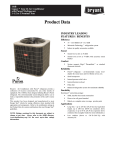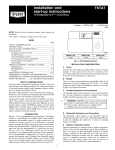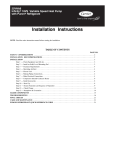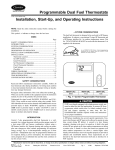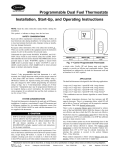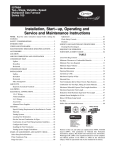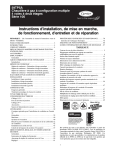Download Bryant T2SNAC01 Instruction manual
Transcript
T2SNAC01, T2SNHP01 NON--PROGRAMMABLE THERMOSTAT Installation Instructions Models There are 2 different models. The 5th and 6th letters of the part number indicate the model. These 2 letters also appear on the package and on the circuit board. Be sure to have the proper thermostat for the intended application. Models are: AC -- 1--stage cool, 1--stage heat for AC systems only. HP -- 1--stage cool, 2--stage heat for either HP, or AC with 2--stage heat. Use each only for its intended purpose. See Table 1. INSTALLATION Thermostat Location Thermostat should be mounted: S Approximately 5 ft. (1.5m) from floor. S Close to or in a frequently used room, preferably on an inside partitioning wall. S On a section of wall without pipes or duct work. A08148 NOTE: Read the entire instruction manual before starting the installation. SAFETY CONSIDERATIONS Read and follow manufacturer instructions carefully. Follow all local electrical codes during installation. All wiring must conform to local and national electrical codes. Improper wiring or installation may damage thermostat. . Recognize safety information. This is the safety--alert symbol When you see this symbol on the equipment and in the instruction manual, be alert to the potential for personal injury. Understand the signal words DANGER, WARNING, and CAUTION. These words are used with the safety--alert symbol. DANGER identifies the most serious hazards which will result in severe personal injury or death. WARNING signifies a hazard which could result in personal injury or death. CAUTION is used to identify unsafe practices which may result in minor personal injury or product and property damage. NOTE is used to highlight suggestions which will result in enhanced installation, reliability, or operation. Power Note that all thermostats are dual powered where batteries can be installed or in the presence of R and C (24vac) are not required. Two AA batteries are furnished with the product. Thermostat should NOT be mounted: S Close to a window, on an outside wall, or next to a door leading to the outside. S Exposed to direct light and heat from a lamp, sun, fireplace, or other temperature--radiating object which may cause a false reading. S Close to or in direct airflow from supply registers and return--air grilles. S In areas with poor air circulation, such as behind a door or in an alcove. Select Model AC Model (1--stage cool, 1--stage heat) is to be used for single stage heating and/or cooling applications only. HP Model (1--stage cool, 2--stage heat) can be used with a single--speed heat pump (HP), or an air conditioner (AC) with a 2--stage furnace or fan coil. Software Option 5 selects HP/AC operation. This thermostat comes configured from the factory as a heat pump thermostat. Select AC in software Option 5 for AC operation. Table 1 – Model Selection and Wiring Diagram Chart AIR CONDITIONER 1 Speed HEAT PUMP 1 Speed Model AC See Fig. Model AC See Fig. Model HP See Fig. Model AC See Fig. Model HP See Fig. ----Model HP See Fig. Model AC See Fig. Model HP See Fig. OUTDOOR UNIT 1--- Stage Furnace 2--- Stage Furnace Typical Fan Coil Variable--- Speed Fan Coil (FK4D, FV4, 40FK) Model HP See Fig. Install Thermostat ! ! WARNING ELECTRICAL OPERATION HAZARD Failure to follow this caution may result in equipment damage or improper operation. T2SN ELECTRICAL OPERATION HAZARD Failure to follow this warning could result in personal injury or death. Before installing, modifying, or servicing system, main electrical disconnect switch must be in the OFF position. There may be more than 1 disconnect switch. Lock out and tag switch with a suitable warning label. 1. Turn OFF all power to unit. 2. If an existing thermostat is being replaced: a. Remove existing thermostat from wall. b. Disconnect wires from existing thermostat, 1 at a time. Be careful not to allow wires to fall back into the wall. c. As each wire is disconnected, record wire color and terminal marking. d. Discard or recycle old thermostat. NOTE: Mercury is a hazardous waste and MUST be disposed of properly. 3. Open thermostat (mounting base) to expose mounting holes. The base can be removed to simplify mounting. Snap apart carefully to separate mounting base from remainder of thermostat. NOTE: If thermostat will not separate, insert a small screwdriver into top slots for ease of opening. 4. Route thermostat wires through large hole in mounting base. Level mounting base against wall (for aesthetic value only -- thermostat need not be leveled for proper operation) and mark wall through 2 mounting holes. 5. Drill two 3/16” (5mm) mounting holes in wall where marked. 6. Secure mounting base to wall with 2 anchors and screws provided, (additional anchoring holes available for more secure mounting if needed) making sure all wires extend through hole in mounting base. 7. Adjust length and routing of each wire to reach proper terminal and connector block on mounting base with 1/4” (6mm) of extra wire. Strip only 1/4” (6mm) of insulation from each wire to prevent adjacent wires from shorting together when connected. 8. Match and connect equipment wires to proper terminals of the connector blocks. (See Table 1.) CAUTION Improper wiring or installation may damage the thermostat Check to make sure wiring is correct before proceeding with installation or turning on unit. 9. Push any excess wire into wall and against mounting base. Seal hole in wall to prevent air leaks. Leaks can affect operation. 10. Snap case back together. 11. Close thermostat assembly making sure pins on back of circuit board align with sockets in connector. 12. Turn ON power to unit. NOTE: If a common wire has not been connected, two AA batteries must be used to power the thermostat. Make sure the customer is informed about changing the batteries every 12 months, if a common wire is not available. If a common wire is connected, then batteries are not needed for any reason. Batteries may be installed if desired but the thermostat will not draw power from them. Set Thermostat Configuration Configuration options are intended to be selected at installation and are normally not modified by the home owner. These options are not discussed in the Homeowner’s Guide and therefore must be made as part of the installation. A special procedure allows entry into the configuration mode. The thermostat will automatically exit this mode if no button is pressed for 3 minutes. While in the configuration mode, up to 14 option choices can be made: Option 01: Anticipator setting Option 02: Clean filter setting Option 03: Fahrenheit or Celsius selection Option 04: Enable fan (G) on with W output Option 05: HP / AC Option 07: Enable zoning Option 10: O (reversing valve) ON with Heat or Cool (present on Heat Pump models only) Option 13: Room temperature offset adjustment Option 15: Enable AUTO mode Option 18: Backlight Configuration Option 19: Equipment Present Option 21: Keypad Lockout An explanation for each of these and how to enter the configuration mode follows. 2 To enter Configuration Mode, hold the FAN button down for approximately 15 seconds. After the 15 second period, Option “01” will appear in the display and the SERVICE icon will be turned on. NOTE: If the FAN button is pressed again or if no button is pressed for 3 minutes, the thermostat will exit the configuration mode and return to normal operation. To reenter the configuration mode, the FAN button must be pressed and held for 15 seconds again. While in configuration mode: The display is used to show both the option number and the selection choice within that option. OPTION 01 -- ANTICIPATOR ADJUSTMENT This adjustment controls the sensitivity and cycle rate of the thermostat. Higher numbers decrease the sensitivity and slow the cycle rate. Lower numbers increase sensitivity and increase cycle rate. However, a limiting feature will not allow more than 6 equipment cycles per hour, regardless of setting. Values can range from 1 to 9. Factory default setting is 3. This default selection will provide optimum performance in nearly all installations. Try it first. Do not change setting unless there is evidence of need to do so. Unlike conventional anticipators, this setting is not to be determined by current draw. There is no need to measure, know, or compensate for current. There is also no droop with this thermostat, regardless of anticipator setting. This adjustment controls only sensitivity and cycle rate up to the maximum of 6 cycles per hour. To Adjust: 1. Enter configuration mode (if not already there). 2. Use up and down buttons to display Option 01. The SET icon should be off. 3. Press MODE button once. The SET icon will come on. The display now shows Option 01 setting. 4. Use up and down buttons to move between the available Option 01 values of 1 to 9. Factory default is 3. 5. Press MODE button again to return to Option 01. The SET icon will now be off. 6. Use up and down buttons to select another Option, or press FAN button to exit configuration mode. OPTION 02 -- CLEAN FILTER TIMER This option selects the number of hours of blower operation (heating, cooling, or fan) before SERVICE FILTER icon is displayed. With OF selected, the icon will never come on, disabling this feature. Time selection can be from 400 to 3600 hours by selecting numbers 1 through 9. (Time is 400 X number selected.) Factory default is 2 (800 hours). Recommended selections are: disposable filter 800 hr, media filter 1200 to 1600 hr, or electronic air cleaner 1600 to 2400 hr of blower operation. To Adjust: 1. Enter configuration mode (if not already there). 2. Use up and down buttons to display Option 02. The SET icon should be off. 3. Press MODE button once. The SET icon will come on. The display now shows Option 02 setting. 4. Use up and down buttons to move between the available Option 02 values of OF and 1 through 9. Factory default is 2. 5. Press MODE button again to return to Option 02. The SET icon will now be off. 6. Use up and down buttons to select another Option, or press FAN button to exit configuration mode. OPTION 03 -- FAHRENHEIT/CELSIUS SELECTION This option selects Fahrenheit or Celsius operation. To Select: 1. Enter configuration mode (if not already there). 2. Use up and down buttons to display Option 03. The SET icon should be off. 3. Press MODE button once. The SET icon will come on. The display now shows Option 03 setting. 4. Use up and down buttons to move between the available Option 03 choices of F (Fahrenheit) or C (Celsius). Factory default is F. 5. Press MODE button again to return to Option 03. The SET icon will now be off. 6. Use up and down buttons to select another Option, or press FAN button to exit configuration mode. OPTION 04 -- G (FAN) ON WITH W OUTPUT This selection determines whether the G (fan) output is to be ON or OFF when any W (furnace or strip heat) output is ON. Most furnaces and fan coils manage their own blowers and do not require a separate G signal. For these applications, select OFF. Some auxiliary heaters require a separate G signal to turn on the blower. In this case, select On. Factory default is OF (off). To Select: 1. Enter configuration mode (if not already there). 2. Use up and down buttons to display Option 04. The SET icon should be off. 3. Press MODE button once. The SET icon will come on. The display now shows Option 04 setting. 4. Use up and down buttons to move between available Option 04 choices of ON or OF. Factory default is OF. 5. Press MODE button again to return to Option 04. The SET icon will now be off. 6. Use up and down buttons to select another Option, or press FAN button to exit configuration mode. OPTION 05 -- HP / AC CONFIGURATION This configuration is available on HP models only. Selecting AC allows the installer to use a HP thermostat in an air conditioner application. To Select: 1. Enter configuration mode (if not already there). 2. Use up and down buttons to display Option 05. The SET icon should be off. 3. Press MODE button once. The SET icon will come on. The display now shows Option 05 setting. 4. Use up and down buttons to move between available Option 05 choices of AC or HP. Factory default is HP. 5. Press MODE button again to return to Option 05. The SET icon will now be off. 6. Use up and down buttons to select another Option, or press FAN button to exit configuration mode. OPTION 07 -- ZONING ON/OFF CONFIGURATION This selection enables or defeats cycle timer, the staging timer, and the compressor timeguard. (See Operational Information for details.) These timers MUST be enabled (zoning OFF) for normal operation and disabled (zoning ON) for zoning applications. In zoning applications, the zone control center performs these timing functions. Factory default is OF. To Select: 1. Enter configuration mode (if not already there). 2. Use up and down buttons to display Option 07. The SET icon should be off. 3 T2SN To enter the configuration mode: T2SN 3. Press MODE button once. The SET icon will come on. The display now shows Option 07 setting. 4. Use up and down buttons to move between available Option 07 choices of ON or OF. Factory default is OF. 5. Press MODE button again to return to Option 07. The SET icon will now be off. 6. Use up and down buttons to select another Option, or press FAN button to exit configuration mode. OPTION 10 -- O (REVERSING VALVE) ON WITH HEAT OR COOL SELECTION This selection is only available on HP model thermostats when HP is selected via Option 05. This selection determines whether the reversing valve is energized in the heating or cooling mode. Factory default is C, energized in cooling. Use up and down buttons to change between H and C. To Select: 1. Enter configuration mode (if not already there). 2. Use up and down buttons to display Option 10. 3. Press MODE button once. The SET icon will come on. The isplay now shows Option 10 setting. 4. Use up and down buttons to move between available Option 10 choices of H (heat) or C (cool). Factory default is C. 5. Press MODE button again to return to Option 10. The SET icon will now be off. 6. Use up and down buttons to select another Option, or press FAN button to exit configuration mode. OPTION 13 -- ROOM TEMPERATURE OFFSET This option allows calibration (or deliberate miscalibration) of room temperature sensor. There are various reasons why the home owner may want to have displayed temperature adjusted to a higher or lower value. The selected number is the number of degrees, plus or minus, which will be added to the actual temperature. The number can range between --5 and +5. Factory default is 0. This adjusted value will be used as actual temperature for both display and control action. For example, if 2 is selected, 72_F/22_C actual will read 74_F/23_C. If setpoint is 72_F/22_C, the room will control to an actual value of 70_F/21_C which will be displayed and acted upon as if it were 72_F/22_C. The effect is that a positive number selection will make the room temperature lower and vice versa. To Select: 1. Enter configuration mode (if not already there). 2. Use up and down buttons to display Option 13. The SET icon should be off. 3. Press MODE button once. The SET icon will come on. The display now shows Option 13 setting. 4. Use up and down buttons to move between available Option 13 choices of --5 through +5 in 1_ steps. Factory default is 0. 5. Press MODE button again to return to Option 13. The SET icon will now be off. 6. Use up and down buttons to select another Option, or press FAN button to exit configuration mode. OPTION 15 -- AUTO MODE ON/OFF SELECTION This options allows the installer to enable or disable AUTO mode (automatic changeover between heat and cool). When disabled, AUTO icon does not appear when successive presses of MODE button are used to move between OFF, HEAT, and EHEAT (in heat pump systems). Factory default is ON (AUTO mode enabled). To Select: 1. Enter configuration mode (if not already there). 2. Use up and down buttons to display Option 15. The SET icon should be off. 3. Press MODE button once. The SET icon will come on. The display now shows Option 15 setting. 4. Use up and down buttons to move between available Option 15 choices of ON or OF. Factory default is ON. 5. Press MODE button again to return to Option 15. The SET icon will now be off. 6. Use up and down buttons to select another Option, or press FAN button to exit configuration mode. OPTION 18 -- BACKLIGHT CONFIGURATION This function is only available when the thermostat is operating from full power via R and C. It is not available when the thermostat operates from batteries. In OF (off) mode, this function is disabled. The thermostat backlight will normally be off. It turns on with any button press and stays on for 10 seconds in between button presses. In ON mode, this function is enabled. The thermostat backlight will normally be on and dim in appearance. The backlight becomes brighter with any button press and remains bright for 10 seconds. Factory default is OF. To Select: 1. Enter configuration mode (if not already there). 2. Use up and down buttons to display Option 18. The SET icon should be off. 3. Press MODE button once. The SET icon will come on. The display now shows Option 18 setting. 4. Use up and down buttons to move between available Option 18 choices of ON or OF. Factory default is OF. 5. Press MODE button again to return to Option 18. The SET icon will now be off. 6. Use up and down buttons to select another Option, or press FAN button to exit configuration mode. OPTION 19 -- EQUIPMENT PRESENT This selection informs the thermostat of the heat, cool, and fan capabilities of the installed equipment. Select number 2, 3, or 4. Default is 4. For equipment with heat and cool capability and fan selection, choose 4. For equipment with only heat or cool, but with fan selection, choose 3. For equipment with only heat or cool and no fan selection, choose 2. To Select: 1. Enter configuration mode (if not already there). 2. Use up and down buttons to display Option 19. The SET icon should be off. 3. Press MODE button once. The SET icon will come on. The display now shows Option 19 setting. 4. Use up and down buttons to move between available Option 19 choices of 2 through 4. Factory default is 4. 5. Press MODE button again to return to Option 19. The SET icon will now be off. 6. Use up and down buttons to select another Option, or press FAN button to exit configuration mode. OPTION 21 -- KEYPAD LOCKOUT In OF (off) mode, the keypad is not locked out and has full functionality. In ON mode, the keypad is locked out and the lock icon on the display is illuminated. To unlock the keypad, the user must press and hold the up and down buttons simultaneously for approximately 5 seconds. The lock icon is turned off and the keypad will remain unlocked as long as the user presses a button at least every 30 seconds or for the entire duration of the installer test mode. If keypad remains idle for 30 seconds and the installer test mode is not in operation, the keypad will return to the locked state and the lock icon will illuminate on the screen. 4 2. Pressing the FAN button while the heating or cooling equipment is not running will turn on the FAN relay and display the FAN icon. 3. If the mode is set to COOL, the first stage of cooling turns on for three, then first and second stages (if a second stage exists) will turn on for three minutes. 4. If the mode is set to EHEAT, auxiliary heat turns on for three minutes, then the mode returns to OFF. Terminating Installer Test After 15 minutes of inactivity (no button presses by the installer), thermostat will automatically revert to normal operation. Pressing RESET FILTER any time during installer test will terminate installer test and return the thermostat to normal operation. Step 5 -- Check Thermostat Operation Fan Operation 1. Press FAN button, starting continuous fan operation. FAN icon turns on. 2. Press FAN button again, stopping fan operation. FAN icon turns off. (Some fan coils have 90 second fan off delay, so fan may not stop immediately.) Checklist 1. Run equipment through several heating and cooling cycles to ensure proper operation. 2. If equipment is to be left in operation, setpoint and operating mode must be properly selected. 3. Put away tools and instruments, and clean up debris. 4. Review Homeowner’s Guide with owner. 5. Leave literature packet with owner. Table 2 – Non--Programmable --C Thermostat Quick Reference THERMOSTAT OUTPUT TSTAT Model T2SNAC01 T2SNHP01 T2SNHP01 Outdoor Unit AC HP AC Thermostat Heat Option 5 N/A OFF ON 24V Hot R R R Furnace W Common Fan C C C G G G Heat Stage 1 W Y W Thermostat Air Conditioner Cool Y Y Fan G G 24VAC R R C Cool Stage 1 Y Y Y Furnace Reversing Valve N/A O/B N/A Air Conditioner W Heat *Common Heat Stage 2 N/A W O/B C W W1 W2 Y Y1 Cool Y Y/Y2 Fan G G 24VAC R R Y HUM C * Common C C C A08161 *Common connection not required if batteries are used. Fig. 2 -- A/C Thermostat with Furnace A08162 *Common connection not required if batteries are used. Fig. 3 -- A/C Thermostat with 2--Stage or Variable Speed Furnace 5 T2SN To Select: 1. Enter configuration mode (if not already there). 2. Use up and down buttons to display Option 21. The SET icon should be off. 3. Press MODE button once. The SET icon will come on. The display now shows Option 21 setting. 4. Use up and down buttons to move between available Option 21 choices of ON or OF. Factory default is OF. 5. Press MODE button again to return to Option 21. The SET icon will now be off. 6. Use up and down buttons to select another Option, or press FAN button to exit configuration mode. Installer Test Mode Installer test will be initiated by pressing the fan button for 20 seconds (15 seconds will enter installer setup) “InS” will appear on the screen and the SERVICE icon will be illuminated. In installer test mode, pressing the MODE button will change the system operating mode. Note that AUTO mode is not available in installer test. Heating and cooling modes must be tested independently. 1. If the mode is set to HEAT, the first stage of heating will be energized for three minutes (180 seconds), and then the first and second stages (if a second stage exists) will turn on for an additional three minutes. Installer test will always attempt to run a second stage output whether it is attached or not, providing a minimum of 6 minutes of first stage operation. At the end of the 6 minute period, the MODE will return to OFF. Thermostat Fan Coil Heat Pump W W O/B Heat W Thermostat Cool Y Y Fan G G 24VAC R R C Air Conditioner W W Y O Heat * Common Fan Coil W Y R C Cool Y Y Fan G G 24VAC R R R C C C C * Common T2SN A08163 *Common connection not required if batteries are used. Fig. 4 -- HP Thermostat with Fan Coil A08164 *Common connection not required if batteries are used. Fig. 5 -- AC Thermostat with Fan Coil WIRING DIAGRAM NOTES: 1. Furnace must control its own second--stage heat operation via furnace control algorithm. Refer to indoor equipment Installation Intructions for proper setup. 2. See Option 5 information to convert HP thermostats to AC thermostat operation. 3. As an option, lock the furnace into low--heat operation and let O/B control high--heat operation. Refer to indoor equipment Installation Instructions for proper setup. 4. O/B can control second--stage heat. Refer to indoor equipment Installation Instructions for proper setup. 5. Refer to outdoor equipment Installation Instructions for latent kit requirements (if any). 6. Terminals marked with * may not be present on equipment. 7. O/B energizes reversing valve in cooling or heating. See Option 10. 8. Refer to outdoor equipment Installation Instructions for proper setup. 9. If system is wired per diagram, the ACRDJ (jumper) on furnace control board should be removed to allow thermostat to control outdoor unit staging. 10. Refer to fan coil Installation Instructions for proper wiring. 11. If batteries are installed, C (common wire) is not required between indoor unit and thermostat. 6 OPERATIONAL INFORMATION Five-- minute Compressor Timeguard The cycle timer limits the number of times the heating or cooling equipment can be energized in one hour. If option 1 is set to a value of 1 or 2, the equipment will be allowed to energize up to six times per hour. If option 1 s set to 3 or greater, then the equipment will be allowed to energize up to four times per hour. This timer is defeated for 1 cycle when the desired temperature is manually changed. It can also be defeated for 1 cycle by simultaneously pressing the FAN button and the INCREASE TEMPERATURE button. Cycle Timer This timer prevents the start of a heating or cooling cycle until at least 15 minutes after the last start of the same cycle. Its function is to assure that equipment is not cycled more than 4 times per hr. This timer is defeated for 1 cycle when the desired temperature is manually changed. It can also be defeated for 1 cycle by simultaneously pressing the FAN mode button and the INCREASE TEMPERATURE button. Staging Timer In multistage heating or cooling, this timer prevents any higher stage from turning on until the preceding stage has been on for 15 minutes. This timer is defeated if the temperature error is greater than 5_F/3_C (usually due to a large change in desired temperature). Three-- minute Minimum On Time Heat/Cool Setpoints (Desired Temperatures) A minimum difference of 2_ is enforced between heating and cooling setpoints. This is done by allowing one setting to “push” the other, to maintain this difference. Auto Changeover When the auto changeover mode is selected, a change from heat to cool (or vice versa) will not occur until an opposite mode demand has existed for 20 minutes. If the setpoint is changed, the 20 minute requirement is deleted. Auto mode may be disabled. Emergency Heat Mode When thermostat is configured as a heat pump and emergency heat mode is selected, all Y signals are locked out and W becomes energized upon a call for heat. Heat On and Cool On Icons When a heating or cooling demand exists, the HEAT ON or COOL ON icon will either remain on or flash. If flashing, the equipment is temporarily prevented from turning on by one of the timers (see above). While the icon remains on without flashing, the equipment is on. Power On Check When AC power is first applied, all segments of the display are turned on for a few seconds. Following this, the temperature display indicates the model/configuration via the following 2 digit code: AC—1--speed air conditioner, HP—1--speed heat pump. Error Codes ---- — If the thermostat cannot properly read room temperature, the display will indicate ---- (2 dashes) and all outputs (except the fan if on) will turn off. This is to prevent operation of the equipment if the thermostat has failed. E2 — If the AC line voltage drops below a minimum (brownout) level, all outputs are turned off and the display indicates E2. This condition will remain for 15 sec after proper line voltage is restored. If the AC line voltage disappears completely, the display will immediately go blank. Thermostat Troubleshooting SYMPTOM Blank LCD “ --- --- ” (2 dashes) on temperature display “E2” on temperature display WHAT TO CHECK Check for 24vac between R and C at terminal connections or battery. Temperature sensor reading out of range. Check sensor for damage. If recycling power does not clear display, thermostat should be replaced. Brownout condition or too low of voltage to thermostat. Double check wiring and check for 24vac between R and C. E2 will clear 15 sec after proper voltage is restored. “SERVICE FILTER” on temperature display After the selected number of hour of blower operation “FILTER” will display on LCD. This is to remind the homeowner to “check” the filter. Press RESET FILTER button to clear display and reset timer to 0. Cooling will not come on Select COOL mode. Set desired temperature to 10˚F below room temperature. Simultaneously press FAN and INCREASE TEMPERATURE buttons to defeat timers. Check for COOL ON icon and 24vac at Y (first--- stage) terminal. If present, thermostat is OK and problem is with equipment or wiring. If not present, replace thermostat. Heating will not come on Select HEAT mode. Set desired temperature to 10˚F/6˚C above room temperature. Simultaneously press FAN and INCREASE TEMPERATURE buttons to defeat timers. Check for HEAT ON and 24vac at Y (first--- stage) terminal (with heat pump) or W (with air conditioner) terminal. If present, thermostat is OK and problem is with equipment or wiring. If not present, replace thermostat. 7 T2SN In normal operation, when a stage turns on, it will not turn off for a minimum of 3 minutes. T2SN E2008 Bryant Heating & Cooling Systems D 7310 W. Morris St. D Indianapolis, IN 46231 Printed in China Edition Date: 03/08 Manufacturer reserves the right to discontinue, or change at any time, specifications or designs without notice and without incurring obligations. 8 Catalog No. IIT2SNAC ---01 Replaces: NEW T2SNAC01, T2SNHP01 NON--PROGRAMMABLE THERMOSTAT Homeowner’s Guide SERVICE FILTER Indicator lets you know it is time to clean or replace your system’s air filter. Room Temperature Display shows current room temperature. COOL ON Indicator is displayed when the cooling equipment is operating. HEAT ON Indicator is displayed when the heating equipment is operating. RESET FILTER Button restarts the timer that calculates the next air filter change or cleaning. AUXILIARY HEAT Indicator is displayed when a heat pump system is operating with auxiliary heat air filter. SETTING & OPERATING THE THERMOSTAT A08147 CONGRATULATIONS INTELLIGENT, EASY TO USE Congratulations on your purchase of a new Bryant thermostat. Your new thermostat combines computer like intelligence with extremely simple operation in an elegant package. Designed to maximize performance, your Bryant thermostat provides reliable, accurate temperature control while blending into any home’s decor. As you read on, you’ll quickly see how easy it is to set up and operate your new thermostat and enjoy the comfort of your home. COMFORT AT YOUR COMMAND Bryant has met the needs of homeowners nationwide with their non--programmable thermostat. Controlling your heating and cooling system at the touch of a button, this powerful device helps deliver comfort year round. MAKING LIFE EASIER Take a few minutes to review the features and functions listed at the right. Bryant gives you control over your comfort with simple instructions, responsive push buttons and an easy--to--read backlit display. Once set, this thermostat reliably monitors indoor temperature and responsively meets your comfort demands. Up and Down Buttons increase or decrease the desired temperature setting. FAN Button chooses between CONTINUOUS FAN and AUTO FAN operation. MODE Button selects between OFF, HEAT, COOL, AUTO, and OFF operation. Heat pump thermostat models also include an EMERGENCY HEAT mode. LOW BATTERY Indicator will light when batteries (if installed) need to be replaced. Setting your indoor temperature set points 1. Press the UP or DOWN button. The LCD readout will be illuminated and the heating or cooling temperature set point will be displayed, but will not change. Next to the temperature display, HEAT or COOL indicates which temperature set point is being displayed. 2. Continue to press the UP or DOWN buttons until your desired heating or cooling temperature set point is displayed. 3. Press the MODE button to select the second temperature setting (either HEAT or COOL). 4. Press the UP or DOWN buttons until your second desired temperature set point is displayed. NOTE: Your COOL setting must be at least 2_ higher than your HEAT setting. Your thermostat will automatically change your previously set temperature to maintain that 2_ difference. Setting fan operation 1. Press the FAN button to switch between ON and AUTO fan se ttings. FAN on indicator will be displayed on LCD. When the ON mode is selected, the fan runs continuously for improved air circulation. When the AUTO mode is selected, the fan runs only as needed to maintain your desired indoor temperature. FAN on indicator is not displayed on LCD. Setting mode operation 1. Press the MODE button. 2. On the LCD readout, the words OFF, HEAT, COOL, and AUTO will rotate as the MODE button is pressed. If you have a heat pump, the LCD readout will show OFF, HEAT, COOL, AUTO, and EMERGENCY HEAT (EHEAT). NOTE: In AUTO mode, your system will heat OR cool as needed to reach your desired temperature. AUTO mode may be disabled. NOTE: If 2 dashes (----) appear, your thermostat does not include the outdoor temperature function or the function is not working properly. Check with your dealer if you are unsure. Service filter feature Your thermostat reminds you when it’s time to change or clean your filter by displaying the SERVICE FILTER indicator. 1. Press the RESET FILTER button after you have changed or cleaned your filter to restart the timer. NOTE: This indicator does not reflect a problem with your system. You have a system error message... The temperature sensor failure indicator sends a “----” reading to the LCD display. This means your thermostat’s temperature sensor is no longer able to measure temperatures. You will need to contact your dealer to repair the problem. An E2 reading on the LCD display means there is not enough voltage for the system to operate. Contact your dealer for further information. If the outdoor air temperature sensor is absent, the outdoor temperature reading will be “----”. The batteries are low... If the batteries are low, the display will indicate a low battery signal on the thermostat. Replace the batteries with two AA alkaline batteries. NOTE: If the product is hard--wired by the installer, the batteries will never have to be replaced. COMMON TERMS A08149 Fig. 1 -- Battery Change Battery change out If the installation requires the usage of batteries, the batteries will require replacement every 12 months. 1. Grasp the front housing of the thermostat along the left side. 2. Carefully pull the front housing away from the back mounting base. 3. Find the two AA batteries along the bottom in back of the front housing. 4. Remove the batteries from the back of the front housing. 5. Install two new AA Alkaline batteries following the + / -polarity markings. 6. Carefully align the front housing with the plastic guides on the right side of the back mounting base. 7. Carefully swing the left towards the back mounting base until it snaps into place. NOTE: If installation is hard--wired, batteries are not required or will not need replacement. AUTO CHANGEOVER Your thermostat provides complete, automatic control over heating and cooling with auto changeover. Auto changeover means your system will automatically heat or cool as needed to maintain your temperature set points. Auto changeover makes life easier because you no longer have to manually switch the thermostat between heating or cooling operation. Just set your heating and cooling set points and let the system do the rest! NOTE: If auto changeover is not necessary in your area of the country, your installer may disable the AUTO mode feature. WHAT IF... The AUXILIARY HEAT indicator is displayed... The AUX HEAT indicator appears on the heat pump version of the thermostat only. It is displayed when your system is operating on auxiliary heat. NOTE: This indicator does not reflect a problem with your system. The SERVICE FILTER indicator is displayed... The SERVICE FILTER indicator tells you when to clean or replace your air filter. Press the RESET FILTER button after cleaning or replacing the filter to turn off the indicator and reset the system. E2008 Bryant Heating & Cooling Systems D 7310 W. Morris St. D Indianapolis, IN 46231 Auxiliary Heat Most heat pump systems require a supplemental heating source, called auxiliary heat, to maintain your comfort when outdoor temperatures fall significantly. Your thermostat lets you know when your home is being warmed with supplemental heat. Service Filter Your system’s air filter will require regular cleaning to reduce the dirt and dust in the system and your indoor air. The SERVICE FILTER indicator lets you know when it’s time to clean the filter. Fan Your system’s fan can run continuously or only as called for during heating or cooling. Continuous operation helps with air circulation and cleaning. Automatic operation provides energy savings. Press the FAN button to make your choice. Mode Mode refers to the type of operation your system is set up to perform. Mode settings include: OFF, HEAT, COOL, and AUTO. Heat pump systems also include EMERGENCY HEAT (EHEAT). Reset Filter The reset filter function turns off the SERVICE FILTER indicator and restarts the system. Press the RESET FILTER button after you’ve cleaned and replaced the system’s air filter. Set Point The heating and cooling temperature set points you wish the system to maintain and have entered into the thermostat. The actual room temperature will automatically be displayed, but you can check the desired temperature by pressing either the UP or DOWN button. While the SET TEMP indicator is lit, press the MODE button to display the desired temperature set points for the other mode. Temperature Sensor The temperature sensor measures the current indoor or outdoor temperatures which are displayed on the thermostat. Up and Down Buttons These buttons are used to set your desired temperature set points. This thermostat includes a five--year limited warranty. For detailed warranty information, please refer to the All Product Limited Warranty Card included in your information packet. This thermostat is also eligible for manufacturer’s extended system warranties. Ask your dealer for details on extended warranties for longer--term protection. Printed in China Edition Date: 03/08 Manufacturer reserves the right to discontinue, or change at any time, specifications or designs without notice and without incurring obligations. 2 Catalog No. IIT2SNAC ---01 Replaces: NEW











